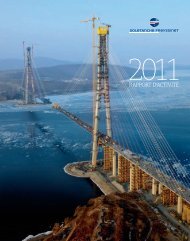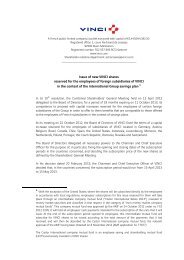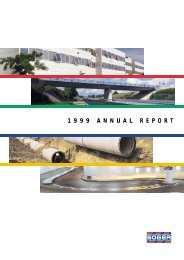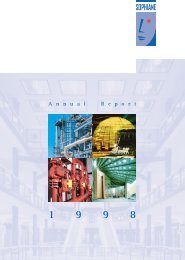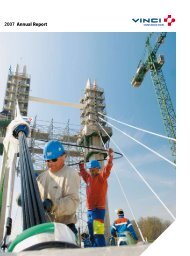VINCI - 2005 annual report
VINCI - 2005 annual report
VINCI - 2005 annual report
You also want an ePaper? Increase the reach of your titles
YUMPU automatically turns print PDFs into web optimized ePapers that Google loves.
These estimates assume the operation is a going concern and are made<br />
on the basis of the information available at the time. Estimates may be<br />
revised if the circumstances on which they were based alter or if new<br />
information becomes available. Actual results may be different from these<br />
estimates.<br />
Revenue<br />
The consolidated revenue of the Energies, Roads and Construction business<br />
lines represents the total of the work, goods and services produced by the<br />
consolidated subsidiaries as their main activity. It includes the Group’s<br />
revenue from concession infrastructure shown in the <strong>VINCI</strong> balance sheet<br />
as concession intangible fixed assets. The method for recognising revenue<br />
in respect of construction contracts is explained in the note on construction<br />
contracts below.<br />
The Concession and services business line’s consolidated revenue comprises<br />
tolls for the use of road infrastructures operated under concessions,<br />
revenue booked by car parks and airport service concessions, and ancillary<br />
income such as fees for the use of commercial installations, rental of<br />
telecommunication infrastructure and advertising space.<br />
In the property sector, revenue arising on lots sold is recognised as the<br />
property development proceeds, using the incurred cost method (cost of<br />
land, of work, etc.).<br />
Revenue from ancillary activities<br />
Revenue from ancillary activities comprises rental income, sales of equipment,<br />
materials and merchandise, study work and fees other than those<br />
generated by concession operators.<br />
Construction contracts<br />
<strong>VINCI</strong> recognises construction contract income and expenses using the stage<br />
of completion method defined by IAS 11.<br />
For the Construction business line, the stage of completion is usually determined<br />
on a physical basis. For the other business lines (Roads and Energies),<br />
the stage of completion is determined on the basis of the percentage of total<br />
costs incurred to date.<br />
For construction projects in which <strong>VINCI</strong>’s share is less than €10 million, it is<br />
considered that the profit or loss recognised on the basis of work completed<br />
is in line with that determined on a stage of completion basis, other than in<br />
exceptional cases.<br />
If the estimate of the final outcome of a contract indicates a loss, a provision<br />
is made for the loss on completion regardless of the stage of completion, based<br />
on the best estimates of income, including any rights to additional revenue or<br />
claims if these are probable and can be reliably estimated. Provisions for losses<br />
on completion are shown under liabilities.<br />
Revenue, including the margin on the construction (profit or loss), realised<br />
in the context of concession contracts shown under concession intangible<br />
fixed assets is recorded in the income statement using the stage of completion<br />
method described above.<br />
Part-payments received under construction contracts before the corresponding<br />
work has been carried out are recognised under liabilities under advances and<br />
payments on account received.<br />
200<br />
<strong>VINCI</strong> <strong>2005</strong> ANNUAL REPORT<br />
Share-based payments<br />
The measurement and recognition methods for share subscription and<br />
purchase plans and the Plans d’Epargne Groupe – Group Savings Scheme<br />
– are defined by IFRS 2 Share-based Payment. The granting of share options<br />
and offers to subscribe to the Group Savings Scheme represent a benefit<br />
granted to their beneficiaries and therefore constitute supplementary<br />
remuneration borne by <strong>VINCI</strong>. Because such transactions do not give rise<br />
to monetary transactions, the benefits granted in this way are recognised<br />
as expenses in the period in which the rights are acquired, with a corresponding<br />
increase in equity. Benefits are measured on the basis of the fair<br />
value of the equity instruments granted.<br />
Share subscription option plans<br />
Options to subscribe to shares are granted to Group employees and officers.<br />
The fair value of the options granted is determined at the grant date<br />
using a binomial valuation model, of the “Monte Carlo” type, adjusting<br />
for the probability of the vesting conditions of the rights to exercise the<br />
option not being met.<br />
Group Savings Scheme<br />
Under the Group Savings Scheme, the Group issues new shares three times<br />
a year reserved for its employees with a subscription price that includes a<br />
discount against the average stock market price of the <strong>VINCI</strong> share during<br />
the last 20 business days preceding the authorisation by the Board of<br />
Directors. This discount is considered as a benefit granted to the employees;<br />
its fair value is determined using a binomial valuation model, of the<br />
“Monte Carlo” type, at the date on which the Board of Directors sets the<br />
subscription price. As certain restrictions apply to the shares acquired by<br />
the employees under these plans regarding their sale or transfer, the fair<br />
value of the benefit to the employee takes account of the fact that the shares<br />
acquired cannot be freely disposed of for five years.<br />
Cost of net financial debt<br />
The cost of net financial debt comprises:<br />
– the cost of gross financial debt, which includes the interest expense<br />
calculated at the effective interest rate, gains and losses on interest rate<br />
hedges in respect of gross financial debt, and net changes in the fair<br />
value of interest rate derivatives that are not used for hedging.<br />
– financial income from investments comprises the return on cash investments<br />
(interest income, dividends from UCITS, disposal gains and losses,<br />
etc.), the impact of interest rate hedges related to these investments and<br />
changes in their fair value.<br />
Other financial income and expenses<br />
Other financial income and expenses mainly comprise foreign exchange<br />
gains and losses, the effects of discounting to present value, dividends<br />
received from unconsolidated entities, capitalised borrowing costs and<br />
changes in the value of derivatives not allocated to interest rate risk<br />
management.<br />
Borrowing costs borne during the construction of assets are included in<br />
the cost of the assets. They are determined as follows:<br />
– to the extent that funds are borrowed specifically for the purpose of<br />
constructing an asset, the borrowing costs eligible for capitalisation on<br />
that asset are the actual borrowing costs incurred during the period less<br />
any investment income arising from the temporary investment of those<br />
borrowings;






